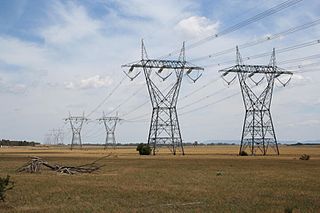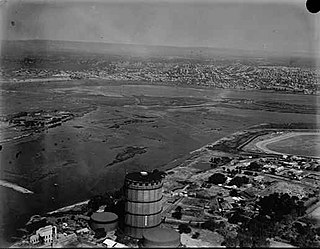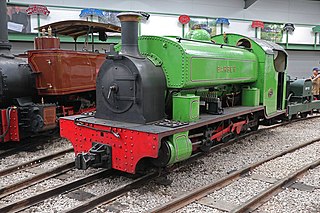Related Research Articles
Coal gas is a flammable gaseous fuel made from coal and supplied to the user via a piped distribution system. It is produced when coal is heated strongly in the absence of air. Town gas is a more general term referring to manufactured gaseous fuels produced for sale to consumers and municipalities.

Gas Works Park is a park located in Seattle, Washington, United States. It has a 19.1-acre (77,000 m2) public park on the site of the former Seattle Gas Light Company gasification plant, located on the north shore of Lake Union at the south end of the Wallingford neighborhood. The park was added to the National Register of Historic Places on January 2, 2013, over a decade after being nominated.

A gas holder or gasholder, also known as a gasometer, is a large container in which natural gas or town gas is stored near atmospheric pressure at ambient temperatures. The volume of the container follows the quantity of stored gas, with pressure coming from the weight of a movable cap. Typical volumes for large gas holders are about 50,000 cubic metres (1,800,000 cu ft), with 60-metre-diameter (200 ft) structures.

A gasworks or gas house is an industrial plant for the production of flammable gas. Many of these have been made redundant in the developed world by the use of natural gas, though they are still used for storage space.
The Gas and Fuel Corporation of Victoria (G&FC) was a government-owned monopoly supplier of household gas in Victoria, Australia. It was established in 1950 and took over two of the three main gas utilities in Melbourne – the Metropolitan Gas Company and the Brighton Gas Company. As part of the conversion to natural gas, in 1971 the corporation acquired the Geelong Gas Company, one of only two remaining private gas companies in Victoria at the time. The Ballarat Gas Company closed at the time. The G&FC was wound up in June 1995.

Orgreave Colliery was a coal mine situated adjacent to the main line of the Manchester, Sheffield & Lincolnshire Railway about 5 miles (8 km) east of Sheffield and 3.5 miles (6 km) south west of Rotherham. The colliery is within the parish of Orgreave, from which it takes its name.

Beckton Gasworks was a major London gasworks built to manufacture coal gas and other products including coke from coal. It has been variously described as 'the largest such plant in the world' and 'the largest gas works in Europe'. It operated from 1870 to 1976, with an associated by-products works that operated from 1879 to 1970. The works were located on East Ham Level, on the north bank of the Thames at Gallions Reach, to the west of Barking Creek.

The Geelong Gas Company was a private company set up to produce and distribute town gas in the city of Geelong. From a gasworks in North Geelong it converted coal into town gas for use in homes and industry. The company was founded in 1858 and existed until 1971 when Geelong was converted to natural gas and the company was bought out by the Gas & Fuel Corporation of Victoria.

Energy in Victoria, Australia is generated using a number of fuels or technologies, including coal, natural gas and renewable energy sources. Brown coal, historically, was the main primary energy source for the generation of electricity in the state, accounting for about 85% of electricity generation in 2008. The amount of coal-fired power has decreased significantly with the closure in 2017 of the Hazelwood Power Station which supplied around 20% of Victoria's electricity, and to a lesser extent with the exit of Anglesea Power Station in 2015. Brown coal is one of the largest contributors to Australia's total domestic greenhouse gas emissions and a source of controversy for the country. Australia is one of the highest polluters of greenhouse gas per capita in the world.

The Gas Light and Coke Company, was a company that made and supplied coal gas and coke. The headquarters of the company were located on Horseferry Road in Westminster, London. It is identified as the original company from which British Gas plc is descended.
Derwenthaugh Coke Works was a coking plant on the River Derwent near Swalwell in Gateshead. The works were built in 1928 on the site of the Crowley's Iron Works, which had at one time been the largest iron works in Europe. The coke works was closed and demolished in the late 1980s, and replaced by Derwenthaugh Park.

The East Greenwich Gas Works of the South Metropolitan Gas Company was the last gas works to be built in London, and the most modern. Originally manufacturing town gas from coal brought in by river and exporting coke and chemicals, the plant was adapted to produce gas from oil in the 1960s. Nothing remains of any of the gas holders; the last gas holder, built in 1886, was dismantled in 2020.

Southall Gas Works is a former gas works site of around 88 acres (36 ha) in Southall, west London, which is currently being redeveloped for mixed-use including 3,750 homes as part of Berkeley Group's The Green Quarter.

East Perth Gas Works was built in 1922 for the Perth City Council to produce town gas from coal, supplying the city of Perth in Western Australia. It could initially supply 28,000 cubic metres (1,000,000 cu ft) of gas per day.

Newstead Gasworks is a heritage-listed former gasometer at 70 Longland Street, Teneriffe, City of Brisbane, Queensland, Australia. It was built from 1873 to 1887. It is also known as Brisbane Gas Company Gasworks and Newstead Gasworks No.2 gasholder. It was added to the Queensland Heritage Register on 24 June 2005.
Kallang Gasworks was the first site dedicated to gas manufacturing from coal in Singapore. It operated from 1862 to 23 March 1998.
The coastal coal-carrying trade of New South Wales involved the shipping of coal—mainly for local consumption but also for export or coal bunkering—by sea to Sydney from the northern and southern coal fields of New South Wales. It took place in the 19th and 20th centuries. It should not be confused with the export coal trade, which still exists today. There was also an interstate trade, carrying coal and coke to other Australian states that did not have local sources of black coal.
The Fitzroy Gasworks was a coal gasification plant in Fitzroy, Victoria. It is notable as the site for the first arc-welded gasholder in the world.

The Windsor Street Gasworks was a coal gas and coke manufacturing site in Nechells, Birmingham. The works were constructed in 1846 for the Birmingham Gas Light and Coke Company adjacent to the Birmingham and Fazeley Canal to allow for the bulk import of coal. The company was taken over by the Birmingham Corporation in 1875 and under mayor Joseph Chamberlain and engineer Charles Hunt the Windsor Street site was expanded and connected to the London and North Western Railway. Hunt's works included the construction, in 1885, of gasholders No. 13 and No.14, the largest in the world at that time, as well as modernisation of production.

Harrogate Gasworks Railway was an industrial railway in the town of Harrogate, North Yorkshire, England. It was built to the gauge of 2 ft and ran between Bilton Junction on the North Eastern Railway, to the Harrogate Gas Company's (HGC) works at New Park, north of the town centre. It opened in 1908 to carry coal to the works for gasification, and outbound byproduct liquids. It closed to traffic in 1956. The railway was noted for its tight gauge restrictions in the tunnel at New Park. Two of its steam locomotives have survived into preservation, and are still in use on heritage railways.
References
- ↑ Circle of Influence – A History of the Gas Industry in Victoria Ray Proudley 1987, Hargreen Publishing Company in Association with the Gas and Fuel Corporation of Victoria
- ↑ Light Railways No.136 April 1997, Light Railways Research Society of Australia
- ↑ Dames & Moore, 'Report, Environmental Audit Area A West Melbourne Gasworks Site,' 2002, Docklands Authority
